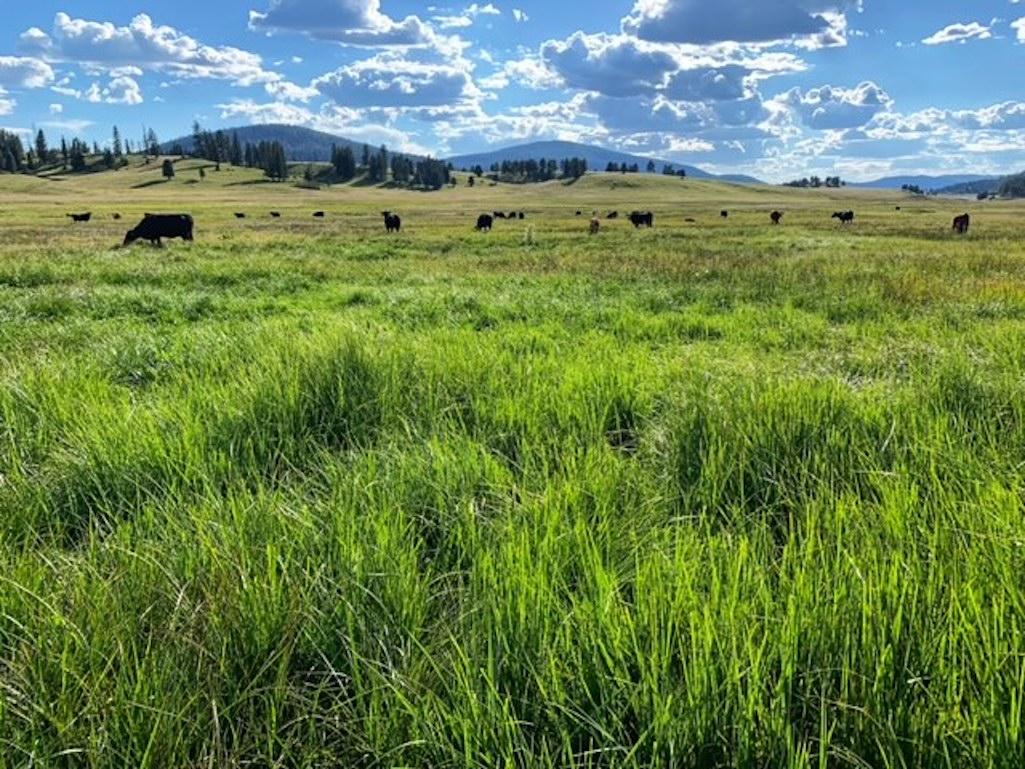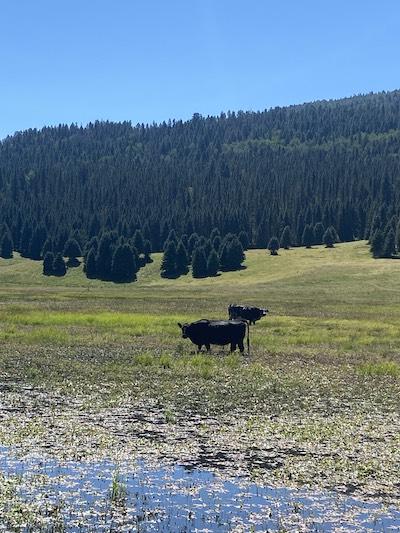
Conservation groups say these cattle are trespassing in Valles Caldera National Preserve/Western Watersheds Project
Illegal livestock grazing at Valles Caldera National Preserve in New Mexico has drawn the threat of legal action against the National Park Service by conservation groups that maintain the cattle are causing damage to important wildlife habitat.
A notice of intent to sue the federal agency was filed Wednesday by WildEarth Guardians, Western Watersheds Project, and Caldera Action. Valles Caldera was set aside as a national preserve to protect its unique ecosystems, headwaters, and thriving elk herds, yet "for years, cattle have illegally entered the VCNP from neighboring Forest Service grazing allotments, causing damage to streams, riparian areas, and important wildlife habitat," the groups claim. Despite voiced concern over the situation, the groups maintain the Park Service has failed to address the issue.
In his October 2021 confirmation hearing, Park Service Director Chuck Sams promised U.S. Sen. Martin Heinrich, D-New Mexico, that he is “committed to figuring a way to ensure that there are no trespass issues.”
So far, this promise has gone unfulfilled as more than 100 cattle have been documented in Valles Caldera meadows for most of the past summer, the conservation groups allege.
“I feel a deep sense of betrayal,” said Madeleine Carey, Southwest conservation manager for WildEarth Guardians. “We were promised this persistent issue would be dealt with and if anything, things have gotten worse. No one from the Park Service has responded to our emails about the cows this summer.”

This photo of cattle in a riparian area of Valles Caldera was taken in September/Madelaine Carey
Even the New Mexico Livestock Board agrees the issue needs attention, the groups said. In June 2019, NMLB passed a unanimous motion to hold a meeting with the Park Service to develop a solution. Still, the issue of trespass persists, the groups added. As recently as October 8th, dozens of cattle were spotted in the Valle San Antonio and Valle Toledo, an area closed to cattle grazing under Park Service regulations, they said.
“We worked for years with others to get the Valles Caldera into the National Park System because the Park Service has the highest standards of land protection of any federal agency,” said Tom Ribe, executive director of Caldera Action, a nonprofit focused on the Jemez Mountains. “We trusted they would protect the Caldera from all sorts of possible damage. They closed the majority of the preserve to cattle grazing but then looked the other way while cows flooded in across vandalized and damaged fences. We have no idea why the management doesn’t respond to this blatant trespass. It is not consistent with Park Service policies.”
The National Park Service does not comment on legal action.
In a press release, the three groups said that "at the beginning of the grazing season in May, volunteers documented the condition of the northern boundary fence between National Park Service and U.S. Forest Service lands. Much of the boundary fence was laying on the ground, cut, or otherwise rendered inoperable. Though the National Park Service has replaced miles of fence, vandalism, tree-falls, and aging fencing continue to allow cattle trespass."
By federal contract, U.S. Forest Service-permitted ranchers are not allowed to graze outside of their specific grazing leases. The Forest Service does not enforce the terms of these contracts when the cattle trespass on national park lands, according to the conservationists.
“Livestock trampling riparian areas of these protected lands has gone on far too long with federal land managers doing too little to stop it,” said Cyndi Tuell, Arizona and New Mexico director of Western Watersheds Project.
Livestock entering Valles Caldera have been documented by the Park Service and Forest Service since at least 2017.
“It’s frustrating that the Park Service is breaking its promise to New Mexicans to protect the natural resources in Valles Caldera and has let this situation fester for more than five years. Species on the brink of extinction like the Jemez Mountain salamander need swift action, not agency foot-dragging,” said Tuell.

 Support Essential Coverage of Essential Places
Support Essential Coverage of Essential Places




Comments
I visited Valles a little over a month ago and saw neither cattle or signs of cattle damage. Nevertheless, assuming the cattle are an issue, it should be an easy problem to fix. Put the responsibility on those that lease the adjacent lands. Require they (the beneficiaries) put up the fence rather than have it an NPS expense. For enforcement, confiscate tresspassing cattle and sell them at market. It won't take many sold cattle to get the cattlemen to comply.
With most Nat'l Forest Service leases, the responsibility to maintain fences lies with the USFS, not the lessee. If the USFS were to shift the responsbility to the lessee, it is very likely that the lessee would either refuse to renew the lease, or demand a lesser rate because of the added expense.
The problem in this case is the USFS, not the lessee or the NPS. As with many things with the USFS, there is little incentive to do the right thing and maintain the fence. And th e rivalry/mistrust/animosity between the USFS and the NPS is well known.
As for confiscating the cattle: that would require that the NPS hire the manpower to round up the cattle. Combined with the refusal of local cattle markets to sell confiscated cattle, KNOWING that they were confiscated by the NPS, there is little chance that confiscated cattle would ever be sold. A potential NM cattle buyer would not do that to his neighbor.
None of the suggested "easy fixes" are viable.
Disagree A. The cattleman already get the leases at very low cost. They want and need that grazing land. There is nothing as cheap available even with the cost of maintaining the fences. As to not being able to sell the cattle, rustlers have been selling cattle for decades. I doubt any processor whould have any qualms in buying them. And it would not take a lot. You could hire a crew for a weekend, rustle up a dozen and the cattlemen would be piling posts in no time.
Having worked for the NPS for 38 years and having dealt with numerous livestock trespass issues, I can tell you that in almost every case the trespass is only prevented when the NPS builds and maintains fences to exclude livestock. Right or wong that is the way it is.
Declare the area a "herd law district" and New Mexico law would allow for liens, confiscation and sale. As I said, it wouldn't take long for the cattlemen to build their own fences.
https://nationalaglawcenter.org/wp-content/uploads/assets/fencelaw/newme...
To point out the obvious here- you cant build fences- or anything for that matter on federal land. It does not matter if you have a lease. Its simply a matter of federal land...which is controlled by the feds.
We should not be putting fences for cattle on public lands for many reasons, not the least of which is the nusance and hazard they represent to other native lifeforms. Cattle are invasive species here and should not be permitted on any public lands. Our elected public lands managers should be focused on removing the cows and assisting the return of the native wildlife that have been displaced in order to cater to the grazing industry.
Chris - leases allow for fences. And Anyman, I take it you are a vegatarian. Or are you on board with the build back inflation better plan?